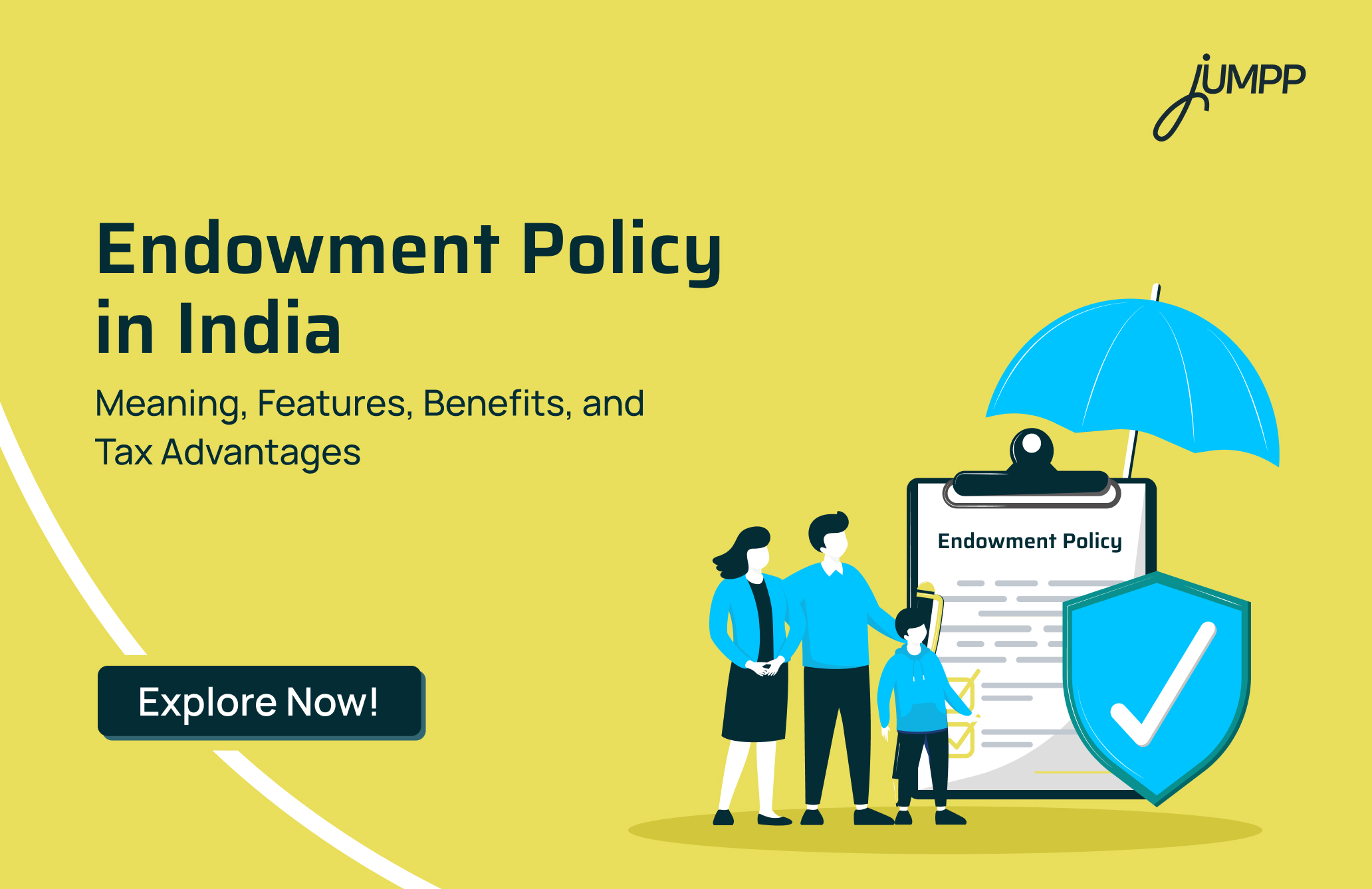Endowment Policy- Meaning, Features, and How It Compares to Term Insurance

When a colleague talks about saving for their child’s education or a friend worries about unexpected expenses, it hits hard to know how unprepared most of us are for the future. Regular savings are never sufficient, and pure life cover doesn’t build wealth. An endowment policy solves both. It is a type of life insurance that provides financial protection for your family while also giving you a lump sum payout if you survive the policy term.
Let us understand the endowment policy meaning and features in detail!
What is an Endowment Policy?
An endowment policy is a type of life insurance that blends life cover with a disciplined savings plan.
Endowment policy meaning- It basically provides a dual benefit: a lump sum payout to the policyholder upon maturity, or a death benefit to their beneficiaries if the insured passes away during the policy term.
Endowment plans are designed to encourage long-term saving for financial goals while offering a safety cover for your family. Also, there is often a potential for bonuses in addition to the guaranteed sum assured.
What are the Key Features of an Endowment Policy
An endowment plan can protect your family and grow your wealth, quietly and systematically.
- Endowment Policy Benefits: It combines protection through life cover with long-term savings.
- Guaranteed Payout: The endowment policy ensures a sum assured is paid either on maturity or in the event of death.
- Bonuses: Depending on the insurer’s performance, additional bonuses or returns may be added on top of the sum assured.
- Forced Savings: An Endowment policy promotes a habit of systematic saving in your lifestyle.
- Add-on Riders: The endowment plan can be enhanced with riders such as critical illness cover, accidental death benefit, or other customised options.
What are the Types of Endowment Policies in India
There are various types of endowment plans in India!
1. Traditional Endowment Plans
- With-Profit (Full Endowment): These policies provide a guaranteed sum assured along with additional bonuses declared by the insurer. The bonuses are added to the total payout.
- Without-Profit (Non-Profit Endowment): Unlike with-profit plans, this type offers a fixed, guaranteed payout on maturity or in case of death, without any bonus or profit sharing.
2. Market-Linked Plans
- Unit-Linked Endowment Plans (ULIPs): ULIPs combine life insurance with investment opportunities. A portion of the premium is invested in funds chosen by the policyholder, and the maturity value depends on the performance of these investments.
This option suits those willing to take market-linked risk for potentially higher returns.
3. Special Purpose Plans
- Low-Cost Endowment: These are designed for targeted financial obligations like mortgage repayment. Such a type of endowment plan features lower premiums while providing a specific sum at the end of the term to clear debts.
- Money-Back Endowment: Also called anticipated endowment plans, these policies provide periodic payouts during the policy term as survival benefits, in addition to the maturity sum assured.
Along with endowment savings, diversifying your investments into stocks or mutual funds can strengthen your portfolio. Do it with the Best Investment App in India!
4. Other Variations
- Participating vs. Non-Participating: This classification depends on whether the policy participates in the insurer’s profits.
Participating plans may offer bonuses. On the other hand, non-participating plans provide fixed benefits.
- Whole Life Endowment: Extending coverage for the insured’s entire life, this plan combines lifelong protection with endowment benefits.
- Child-Oriented Endowment: These are specifically created to build a corpus for a child’s future. These plans often include premium waiver benefits in case of the parent’s unforeseen death.
Endowment Policy Tax Benefits
Endowment plans not only provide insurance and savings but also come with attractive tax benefits.
1. Tax Benefits on Premiums
Section 80C Deduction: Premiums paid for an endowment plan are eligible for tax deduction under Section 80C of the Income Tax Act.
This is one of the most commonly used exemptions and can significantly reduce your taxable income.
Deduction Limit: The maximum deduction allowed under Section 80C is ₹1.5 lakh per financial year. If your combined eligible investments under Section 80C exceed this amount, the excess will not be deductible.
Eligible Expenses: The deduction can be claimed for premiums paid for yourself, your spouse, and your children, making it a useful tool for family financial planning.
2. Tax Benefits on Maturity and Death Benefits
Section 10(10D) Exemption: The lump sum received at maturity or paid to the nominee in the event of the policyholder’s death is typically tax-free under Section 10(10D). This ensures that the returns on your disciplined savings are preserved and not eroded by tax liabilities.
Key Conditions: To enjoy the tax-free status on maturity proceeds, certain conditions must generally be met:
- The policy must have been issued after 1 April 2012.
- The annual premium paid must not exceed 10% of the sum assured.
- The policy must not have been surrendered or terminated prematurely.
Endowment Policy vs Term Insurance: Which One Should You Choose?
An endowment policy combines life insurance with a savings component, paying a lump sum either on maturity or as a death benefit.
Term insurance, in contrast, is pure life protection, providing a payout only if the policyholder passes away within the policy term.
Endowment Policy vs Term Insurance- What is the Basic Difference
| Feature | Endowment Policy | Term Insurance |
| Primary Purpose | Dual benefit of insurance and forced long-term savings. | Pure life coverage for a specific period. |
| Maturity Benefit | Pays a lump sum (sum assured plus bonuses) if the policyholder outlives the term. | No payout if the policyholder survives the term, except in “Return of Premium” variants. |
| Premium Cost | Considerably higher, as a portion goes into savings/investment. | Significantly lower and more affordable for higher coverage. |
| Sum Assured | Lower sum assured for a given premium due to the savings component. | Offers a higher sum assured for the same premium. |
| Risk Level | Lower risk with guaranteed returns, though they may be modest compared to market-linked investments. | No investment risk, purely protection-focused. |
| Flexibility | Less flexible, limited liquidity, though some plans allow loans against the policy. | Highly flexible with various terms and payout options. |
| Tax Benefits | Premiums are eligible under Section 80C; payouts under Section 10(10D). | Premiums eligible under Section 80C; death benefits under Section 10(10D). |
Which One Should You Choose?
The right choice depends on your purpose of getting insurance, your current life stage, and your priorities.
You should choose an endowment insurance plan if you want to:
- Save systematically for your long-term goals
- Balance your savings with protection
- Receive a guaranteed payout regardless of market performance, preferring low-risk returns.
You must choose a term insurance policy if you want to:
- Ensure pure financial protection for your family in case of untimely death.
- Get the highest coverage possible at the most affordable premium.
Not sure whether to invest in an endowment plan or a safer option like fixed deposits?
Check out our complete guide on FD vs Life Insurance to understand which option suits your financial goals best.
Conclusion
An endowment policy is a structured way to save, invest, and protect your family financially. By combining life cover with systematic savings, it provides security and growth simultaneously.
Whether for funding future goals or ensuring a safety net for your loved ones, endowment policies offer a disciplined, tax-efficient approach to building long-term wealth.
Endowment Plan India- FAQs
An endowment policy is a type of life insurance that also includes a savings component. It provides a lump-sum payout to the policyholder if they survive the policy term, or to the nominee if the policyholder passes away during the term.
Endowment funds typically offer conservative returns. These are usually around 5% to 6% per year. In some cases, returns can be even lower than the rate of inflation.
Endowment policies can be inefficient because they combine insurance and investment into one plan.
The policyholder benefits if they survive the policy term, receiving a guaranteed lump-sum payout. The nominee or family benefits from the death benefit if the policyholder passes away during the term.
The main drawbacks include relatively low returns that may not beat inflation, high premiums compared to pure term insurance, long-term rigidity, and limited flexibility in accessing funds.
The maturity period is fixed when the policy is purchased. Some of the common terms range from 10 to 30 years.
A few risks of the endowment policies include inflation risk, as the guaranteed returns may not keep pace with rising costs, and liquidity risk, because funds are locked in for a long period.
Endowment policies offer the dual advantage of life insurance protection and long-term savings in a single plan. They also provide tax benefits on premiums under Section 80C and on the maturity or death payout under Section 10(10D).






